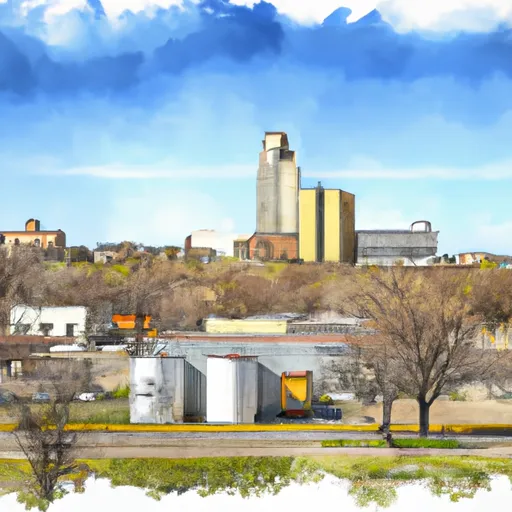-
 Snoflo Premium
Snoflo Premium
Get unlimited access to all our content
With no Ad interruptions! - Start Your Free Trial Login with existing account
Smith-Center
Eden Index
Climate
8.1
•
Recreation
0.3
•
Community
1.4
•
Safeguard
3.7/10

Smith Center is a small city located in north-central Kansas, known for its pleasant climate, diverse hydrology constituents, and numerous outdoor recreation opportunities. The region experiences a typical Midwestern climate with hot summers and cold winters. Average temperatures range from around 20°F (-6°C) in winter to 90°F (32°C) in summer, with moderate rainfall throughout the year.
Hydrologically, Smith Center is part of the Republican River Basin, which consists of numerous streams, springs, and reservoirs. The region's hydrology constituents include the South Fork Solomon River, Oak Creek, and other smaller tributaries. These water sources not only provide scenic beauty but also support various aquatic activities like fishing, boating, and swimming.
Outdoor enthusiasts will find plenty of recreational opportunities in Smith Center. The region offers excellent hunting grounds for deer, pheasant, and waterfowl. Additionally, there are several nature trails and parks for hiking, camping, and picnicking. Smith County State Lake, located just outside the city, is a popular destination for fishing and boating enthusiasts. The lake is stocked with various fish species, including bass, catfish, and crappie.
In conclusion, Smith Center, Kansas, offers a pleasant climate, diverse hydrology constituents, and numerous outdoor recreation opportunities, making it an ideal destination for nature lovers and outdoor enthusiasts.
What is the Eden Index?
The Snoflo Eden Index serves as a comprehensive rating system for regions, evaluating their desirability through a holistic assessment of climate health, outdoor recreation opportunities, and natural disaster risk, acknowledging the profound impact of these factors on livability and well-being.
Climate Health Indicator (CHI): 8.1
Smith-Center receives approximately
642mm of rain per year,
with humidity levels near 82%
and air temperatures averaging around
12°C.
Smith-Center has a plant hardyness factor of
6, meaning
plants and agriculture in this region thrive during a short period during spring and early summer. Most
plants will die off during the colder winter months.
By considering the ideal temperature range, reliable water supplies, clean air, and stable seasonal rain or snowpacks, the Climate Health Indicator (CHI) underscores the significance of a healthy climate as the foundation for quality living.
A healthy climate is paramount for ensuring a high quality of life and livability in a region, fostering both physical well-being and environmental harmony. This can be characterized by ideal temperatures, reliable access to water supplies, clean air, and consistent seasonal rain or snowpacks.
Weather Forecast
Streamflow Conditions
Smoky Hill
Area Rivers
Smoky Hill
Snowpack Depths
Smoky Hill
Reservoir Storage Capacity
Smoky Hill
Groundwater Levels
Recreational Opportunity Index (ROI): 0.3
The Recreational Opportunity Index (ROI) recognizes the value of outdoor recreational options, such as parks, hiking trails, camping sites, and fishing spots, while acknowledging that climate plays a pivotal role in ensuring the comfort and consistency of these experiences.
Access to outdoor recreational opportunities, encompassing activities such as parks, hiking, camping, and fishing, is crucial for overall well-being, and the climate plays a pivotal role in enabling and enhancing these experiences, ensuring that individuals can engage in nature-based activities comfortably and consistently.
Camping Areas
| Campground | Campsites | Reservations | Toilets | Showers | Elevation |
|---|---|---|---|---|---|
| Luray North City Park | None | 1,589 ft | |||
| South Park Municipal Campground | 6 | 1,850 ft | |||
| Smith Center Roadside Area | None | 1,793 ft | |||
| Minooka - Wilson Reservoir | 220 | 1,577 ft | |||
| Fort Kearny State Rec Area | 110 | 2,110 ft | |||
| Cheyenne State Rec Area | 8 | 1,961 ft | |||
| War Axe State Rec Area | 8 | 2,010 ft | |||
| Hoisington Park | 12 | 1,836 ft | |||
| Windmill State Rec Area | 89 | 2,055 ft | |||
| Bassway Strip State Wildlife Area | None | 2,090 ft |
Nearby Ski Areas
Catastrophe Safeguard Index (CSI):
The Catastrophe Safeguard Index (CSI) recognizes that natural disaster risk, encompassing floods, fires, hurricanes, and tornadoes, can drastically affect safety and the overall appeal of an area.
The level of natural disaster risk in a region significantly affects safety and the overall livability, with climate change amplifying these risks by potentially increasing the frequency and intensity of events like floods, fires, hurricanes, and tornadoes, thereby posing substantial challenges to community resilience and well-being.
Community Resilience Indicator (CRI): 1.4
The Community Resilience Indicator (CRI) recognizes that education, healthcare, and socioeconomics are crucial to the well-being of a region. The CRI acknowledges the profound impact of these elements on residents' overall quality of life. By evaluating educational resources, healthcare accessibility, and economic inclusivity, the index captures the essential aspects that contribute to a thriving community, fostering resident satisfaction, equity, and social cohesion.

